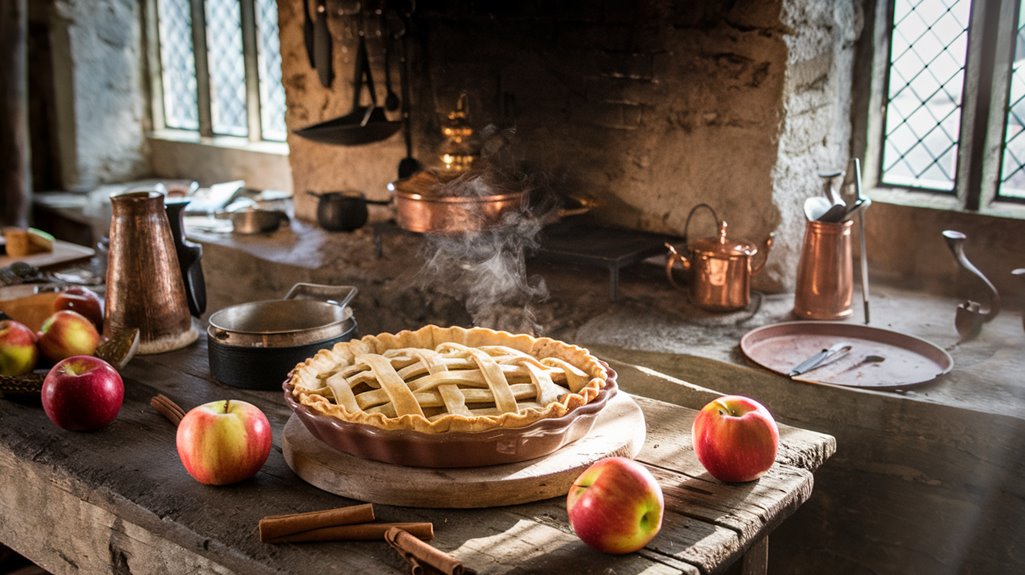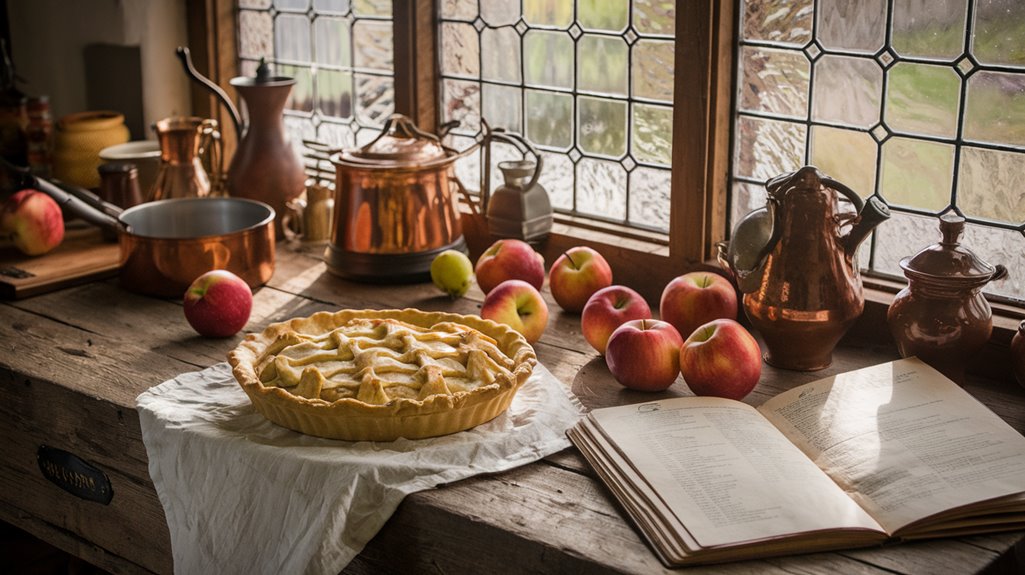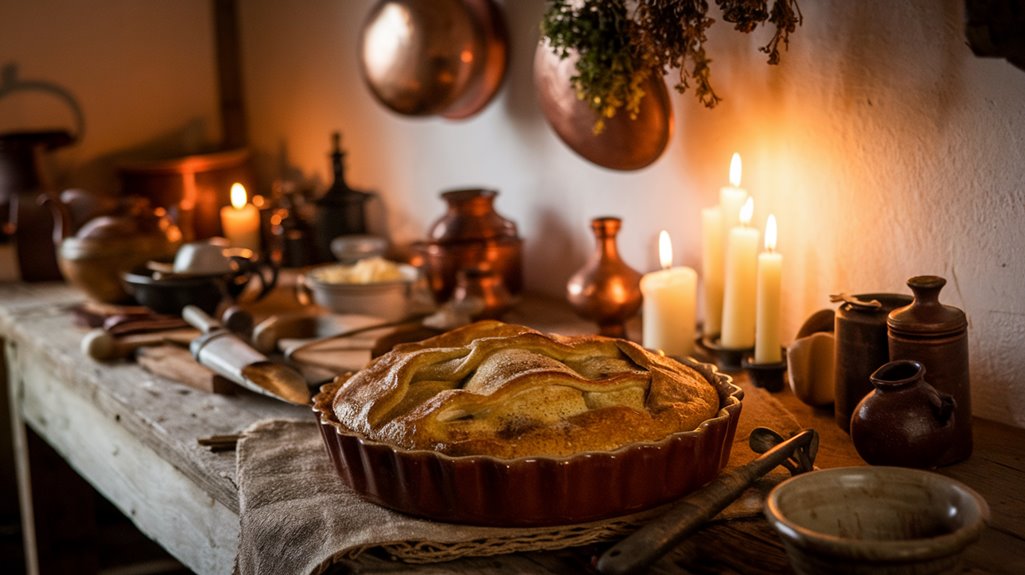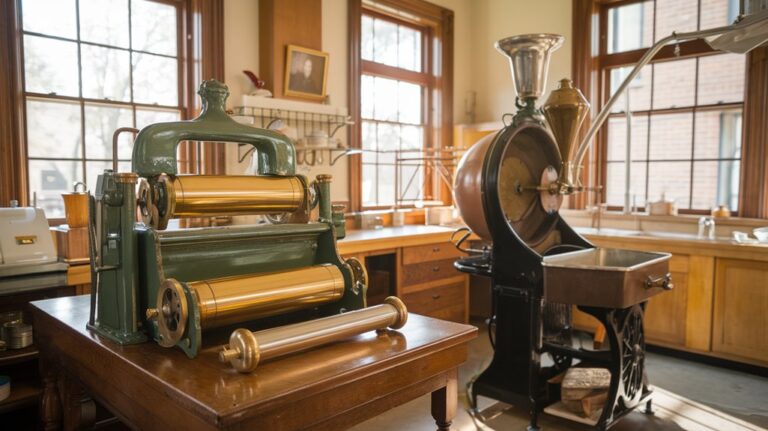Apple Pie Wasn’t Originally American
You've probably heard the phrase "as American as apple pie" countless times, but here's a surprising truth: this beloved dessert isn't American at all. While you might picture colonial bakers crafting the first flaky crusts filled with cinnamon-spiced apples, the real story begins across the Atlantic in medieval England. The tale of how this European creation became America's culinary mascot reveals fascinating insights about food culture, immigration, and national identity.
The Medieval English Roots of Apple Pie

While many consider apple pie quintessentially American, its origins trace back to medieval England, where the first recorded recipe appeared in "The Forme of Cury" from 1381.
You'll find that medieval agriculture shaped the earliest versions of this dessert, as sugar was scarce and cooks relied on figs, raisins, and pears for sweetness. By the sixteenth century, recipes evolved to include refined sugar use, reflecting increased access to this once-rare ingredient.
The recipe emerged from King Richard II's royal kitchen, where historical spices like cinnamon and nutmeg, influenced by Ottoman trade, enhanced the filling. The tradition of serving apple pie later made its way to America where European settlers adapted these recipes to their new home.
The pie's crust, known as a "coffin," wasn't meant to be eaten but served as a tough container.
Medieval dietary beliefs, particularly those of Galen, suggested serving apple-based dishes at the end of meals to aid digestion, a practice that influenced how and when people enjoyed this now-iconic dessert.
How Apples Made Their Way to American Soil
The journey of apples from medieval England to American soil reveals a fascinating tale of perseverance. When European settlers first arrived, they brought grafted apple trees that struggled in the harsh American climate.
You might be surprised to learn that it wasn't until they started planting seeds from apples eaten during their Atlantic voyage that apple cultivation truly took root. This pioneering method aligned with the colonists' vision, as they viewed their journey to America as a symbolic rebirth of civilization.
The introduction of honeybees for pollination proved essential, and by 1800, American farmers had developed over 14,000 varieties. Johnny Appleseed spread apple cultivation throughout the frontier by establishing mobile nurseries in the early 1800s.
Early settlers prioritized cider production, as it was safer to drink than water and easier to make than beer. The first American apple orchard, planted in Boston in 1625 by William Blaxton, marked the beginning of an agricultural revolution that would transform the landscape and establish apples as a cornerstone of American culture.
European Settlers and Their Pie-Making Legacy
As European settlers established roots in the American colonies during the 17th century, they brought cherished pie-making traditions that would shape America's culinary future.
The English introduced their apple pie recipes, while the Dutch contributed their distinctive lattice-style crusts developed in the 15th century. You'll find that these settlers adapted their pie variations to incorporate ingredients from Asia and the Middle East, like cinnamon and nutmeg. Initially, the English made crust-less pies due to the high cost of sugar in the 14th century. In addition to dessert pies, settlers commonly made pies containing fish and meat fillings.
The cultural significance of apple pie grew as settlers developed sweeter apple varieties suitable for baking.
What began as primarily savory dishes in northern Europe evolved into beloved desserts in America. By the 1800s, apple pie had become so embedded in American culture that it transformed from its European origins into a symbol of American prosperity, despite its undeniable Old World roots.
The Birth of "As American as Apple Pie"
You'll find the phrase "as American as apple pie" first appeared in a 1902 newspaper article, though historical misconceptions about its origins persist. Despite apple pie's European roots, it became deeply woven into American cultural symbolism.
The connection grew stronger during World War II when soldiers cited "mom and apple pie" as what they were fighting for back home. The sentiment gained further traction when a 1924 Gettysburg Times advertisement compared the American quality of suits to apple pie. Early English recipes dating back to 1381 contained unique ingredients like figs, raisins, and saffron.
While it might seem paradoxical that a dessert with English roots and Asian ingredients became America's culinary mascot, it perfectly represents the nation's melting pot nature.
In fact, native fruits like blueberries would've been a more historically accurate symbol of American cuisine.
Why Americans Embraced Apple Pie as Their Own

Cultural adaptability sparked America's embrace of apple pie, transforming an imported dessert into a cherished national symbol.
You'll find that early European settlers, particularly the Dutch and Germans, brought their culinary traditions and preservation techniques, which helped establish apple pie's foothold in colonial America.
The cultural symbolism deepened as culinary adaptations reflected America's melting pot nature. Ancient Egyptians created the first pies with inedible pie crusts that were merely vessels for holding the filling.
Americans cultivated and developed over 14,000 apple varieties through dedicated farming efforts.
You can trace this evolution through various regional interpretations, from the Midwest's tradition of serving it with cheese to unique family recipes passed down through generations.
During World War II, the phrase "as American as apple pie" gained prominence when soldiers cited it as something worth fighting for.
This sentiment, combined with Johnny Appleseed's legendary contribution to apple cultivation, cemented the pie's status as a unifying symbol of American identity.
Debunking the American Apple Pie Origin Story
Despite its iconic status in American culture, apple pie's true origins paint a different picture than the commonly held belief of it being a native creation.
You'll find the first recorded recipe in England in 1381, long before America's colonization. The culinary evolution of apple pie spans multiple continents, with influences from France, the Netherlands, and the Ottoman Empire. Much like effective study habits, understanding the history requires critical thinking to separate fact from fiction.
What's more surprising is that apples aren't native to North America – they originated in Central Asia.
When colonists arrived, they brought European apple trees primarily for cider production, not pie-making. Hard cider was actually the preferred beverage of early Americans.











